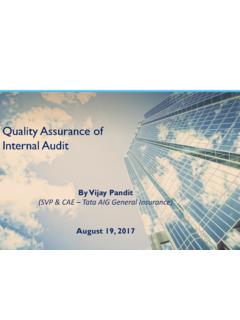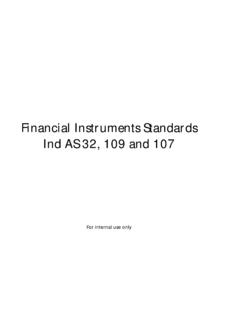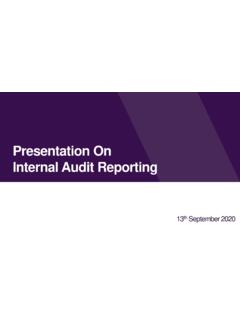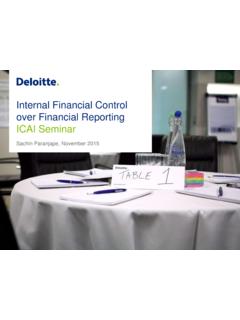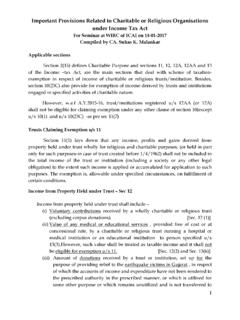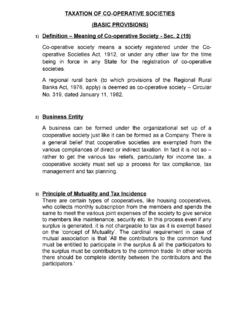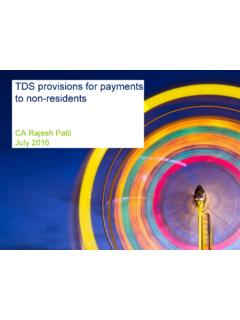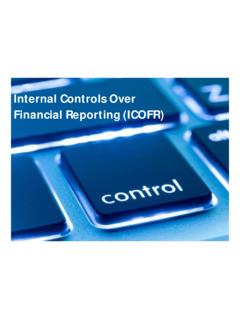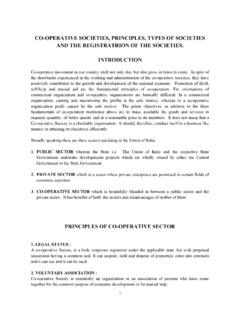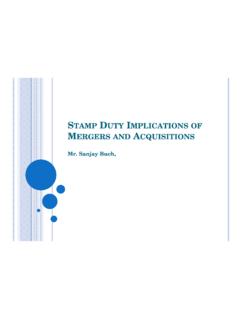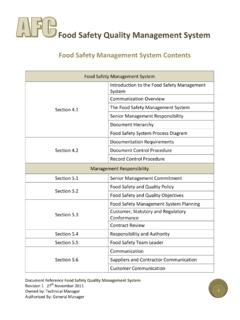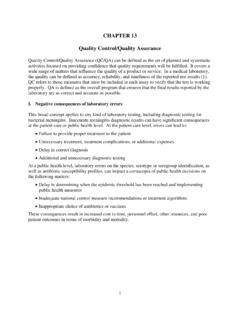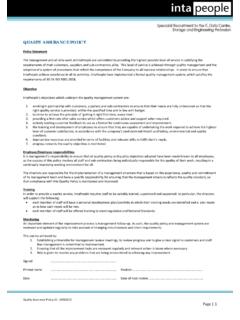Transcription of Quality Assurance in Internal Audit - WIRC-ICAI
1 Quality Assurance in Internal Audit1 Standard on Internal Audit (SIA) 7 AgendaExternal Quality ReviewKey StatisticsInternal Quality ReviewIntroductionExpectations from Internal AuditComparison with IIAQ uality Assurance FrameworkRecapIntroductionGiven the different elements of Quality , the key steps are: Recognizing who the stakeholders are What are the expectations of these stakeholdersIs Internal Audit Addressing Stakeholders Needs? How much risk am I allowed to take? What is our corporate risk appetite?General Managers How well does senior management understand risk? How great is management s risk awareness?
2 What is their ability to manage compliance with the regulatory requirements?Regulators How efficient is our current risk financing strategy? Does the current risk management strategy adequately capture the key risks?Risk Managers What could we do to further minimize our legal and regulatory liabilities?General Counsel How are we managing business risks? How are we assured they are being covered appropriately under Audit ?Board/ Audit Committee What risks could materially impact our financial results?CFO What unforeseen events might disrupt our strategy and prevent achievement of our goals?CEO/COOE xpectations from Internal AuditExpectations from Internal Auditors Continuing responsibility to maintain professional knowledge and skills at a level required Ensure competent professional service based on latest developments in.
3 Internal Audit Profession Economy Industry LegislationSIA -2 Quality Assurance FrameworkConsider the following while establishing Quality Assurance frameworkQuality Assurance FrameworkIA scope and objectivesDefine the Audit UniversePrepare the Risk Based Audit PlanEngagement PlanningAllocation of ResourcesFieldworkReviewReportingQuality Assurance over entire Internal Audit ActivityIndependence & ObjectivityProficiency and Due Professional careElements of Internal Audit Activity Objectives of Quality Assurance ProgramQuality Assurance program should perform evaluation ofCoverage of Quality Assurance programAspects of Internal Audit to be covered from the following perspectivesInternal Quality Assurance ReviewsInternal Quality Assurance ReviewsAdequate supervision is the basis of a Quality programme and also the foundation upon which Internal and external assessments are conductedEffective supervision ensures compliance with Internal Audit PolicyInternal Auditing StandardsInternal Audit Quality Assurance ReviewsOngoing Monitoring (Engagement Manager)
4 Ongoing Review of workpapers and sign off Feedback from auditee Units Internal Audit Automation and checks Appropriate measure to ensure adequate time and resources are spent on high risk and complex areasPeriodic Self Assessment (Other than engagement Manager) Adherence to Internal polices and procedures Review of work papers Quality of supervision Review of performance metricsMethods/ Parameters for continuous monitoring of Internal Audit activityExternal Quality Assurance ReviewsExpectations from External Quality reviewer Independent review Grant Assurance as to whether IA is acting in accordance with its mission and charter Provide feedback of how IA is received by the Audit committee, senior management and Internal clients (line management)
5 Supply senior management with real-world recommendations for Internal Audit Leading Good Practices Identify whether IA meets or exceeds applicable standards Evaluate whether the company s Audit planning process is sufficiently comprehensive and appropriately focused Provide an independent assessment over Audit report Quality , timeliness and completeness of follow-up procedures Provide recommendations that will assist Internal Audit in aligning itself with strategic goals of the Company Established methodology and technology that will make the process more efficient Go beyond the minimum requirements set forth by the IIA and ICAIWhat The Reviewer Should Look For Independence / Objectivity Proactive Approach Risk Based Approach Alignment with Corporate Objectives Understanding of the Business Acts as a Catalyst for Change Innovative and Consultative Leveraging Technology and Leading Practices Effective
6 Communication and Relationships Value Perception Dynamic and FlexiblelBusiness risk focuslMeeting/exceeding stakeholder expectationslValue-added recommendationslEfficiency and effectiveness of operationsGather InformationOpportunity FactorsFocus is on effectiveness of operations, stakeholder perceptions, compliance to standards and Internal Audit practices Interviews with senior and line management Interviews with Audit Committee Staff and management questionnaires Review of IA resources and personnel Review of Internal Audit work products for compliance to standards Bench-marking against Leading PracticesPerform AnalysisKey Focus AreaslOrganization/PeoplelProcesses/Meth odologieslStakeholder PerceptionslPerformanceRecommendations & Action PlansQuality Assessment ApproachInterview/ surveyConduct surveys/ interviews of.
7 Audit Committee members Senior/executive management CAE Internal Audit senior level members Internal Audit staff membersKey metrics for benchmarking Staff levels Staff knowledge and skills Training hours IA cost with component wise breakup Areas outsourced IA plan distributionConclusion and Reporting Discuss the gaps and recommendations with the CAE Contents of the QAR report typically includes: Executive summary Process Benchmarking Interviews conducted and interview results Survey results Compliance status with standards (IIA/ ICAI) Generally Compliance Partial Compliance Non compliance Suggestions of leading good practice opportunities for consideration by the Internal Audit team Results of the external Quality assessment review should be communicated to the senior management and Board/ Audit Committee including the plan of action for implementation of added Value of Quality Assessment Is Internal Audit focused on the right things?
8 Is Internal Audit properly equipped to contribute the appropriate value to the organization? Does Internal Audit play a key role in the corporate governance and risk management process? Does Internal Audit understand stakeholder needs and expectations? And are they meeting them? Do Internal Audit practices reflect the successful practices of the profession? Does Internal Audit have the right strategies for future success? Is Internal Audit viewed as a trusted business risk and control advisor?A Quality Assessment should go above and beyond confirming compliance to the standards . Key questions include:Key StatisticsAbsence of formal policy and procedures for QAIP - 38% Organizations performing ongoing Internal assessment reviews 76%Organizations performing periodic Internal assessment reviews 56%Ongoing reviewStatisticsPeriodic reviewStatisticsEngagement Supervision87%In-depth Interviews38%Checklist74%Self assessment73%Feedback81%Benchmarking64%B udget and Timekeeping65%Peer reviews9% Audit plan completion85%Combination22% Internal assessment review methods used:Key StatisticsSharing of Internal assessment results.
9 Senior management 61% Audit committee - 67% Board of Directors 16% No one 15%Types of external Quality assessment review: Self assessment with independent external validation 19% Independent and external assessment 81%Frequency of external Quality assessment review: 1 to 2 years 5% 3 to 4 years 29% 5 years 65% Others 1%.Key StatisticsAres covered in an external assessment review: Compliance with professional standards 93% Review of Charter and IA policy manual 96% Legislation and Regulatory compliance 52% Management expectations 85% Integration with Governance process 67% Audit Process, tools and techniques used 90% Staff Mix, knowledge and expertise 93% Whether IA adds value 72%Comparison with IIA Develop and maintain a Quality Assurance and Improvement Program ( QAIP ) that covers all aspects of the Internal Audit activity and continuously monitors its effectiveness.
10 Process to monitor and assess overall effectiveness of Quality program. Include both Internal and external assessments system of Quality Assurance should include policies and procedures addressing: Leadership responsibilities for Quality in Internal Audit Ethical requirements Acceptance and continuance of client relationship or specific engagement Human Resources Engagement performance - 1300 SIA - 7 Comparison with IIA Internal assessments include ongoing reviews and periodic reviews External assessments - Once every five years The CAE should communicate the results of external assessments to the board The Internal Quality review To be done by person responsible for Quality Assurance and/ or other experienced member(s)
